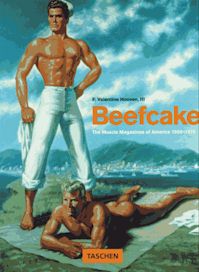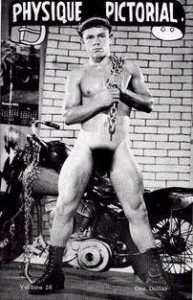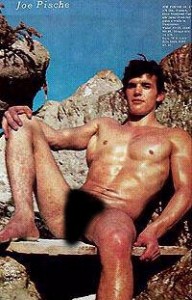I saw my first physique magazine when I was 13 years old (1966), in a newsstand in downtown Miami. Though I did not yet know what I was, I knew that I found other men attractive, and I was instinctively drawn to the magazines’ models, who were completely nude from the back or tastefully covered with a posing strap.
Of course having a 13-year old poring through his physique mags was the last thing the old man who ran the newsstand wanted, and he was quick to chase me away every time he caught me looking at the magazines (this happened quite often).
Still, what little I saw confirmed what I instinctively knew: that, at its best, the male body is the most beautiful thing on God’s green Earth. Coming from a family and a culture that thought men were ugly, it was an epiphany.
By the time I came out of the closet (1973), the physique magazines were a thing of the past, victims of their own success. Full-frontal nudes were no longer considered obscene, and openly gay magazines appeared that proclaimed what the beefcake mags could not admit; that they published shots of naked men for the erotic entertainment of other men. Still, I never lost interest in the physique magazines, both for their own sake and as an important part of gay social and cultural history.
This article owes much to Taschen, publishers of Beefcake: The Muscle Magazines of America 1950-1970, by F. Valentine Hooven, III and, in three volumes, The Complete Reprint of Physique Pictorial 1951-1990. I also consulted Physique: A Pictorial History of the Athletic Model Guild, edited by Winston Leyland (Gay Sunshine Press) and Hard to Imagine: Gay Male Eroticism in Photography and Film from Their Beginnings to Stonewall, by Thomas Waugh (Columbia University Press).
 The father of physique magazines was Bob Mizer (1922-1992). In 1945 Mizer started the Athletic Model Guild in Los Angeles as a modeling agency for male body-builders.
The father of physique magazines was Bob Mizer (1922-1992). In 1945 Mizer started the Athletic Model Guild in Los Angeles as a modeling agency for male body-builders.
Mizer, a self-taught photographer, recruited and photographed the models, carefully listing their vital statistics along with their real names and ages. Mizer sold his photos by mail, advertising them in men’s magazines.
By 1951 Mizer’s catalog was so extensive that he began to collect his photos and sell them in a magazine format. Thus was Physique Pictorial born.
The first publication of its kind, Physique Pictorialshowcased a generation of male pinups and bodybuilders, including Jack LaLanne, Steve Reeves, Ed Fury and Joe Dallesandro; as well as art by the likes of George Quaintance, Tom of Finland and “Art-Bob”.
The success of Physique Pictorial led Mizer to produce 8 mm. short films, with campy titles like Aztec Sacrifice, Cruel Stepbrothers, and Days of Greek Gods.
Physique Pictorial became a hit with thousands of men, and it was soon joined by a slew of imitators who hoped its success would rub off on them. Soon newsstands carried titles like the Grecian Guild Pictorial, Adonis, Young Adonis, Body Beautiful, and Tomorrow’s Man. Chicago’s Chuck Renslow, later renowned as the producer of the International Mr. Leather contests, started Kris Studios and published Triumph and Mars, which became showcases for Renslow’s lover, the artist Etienne (Dom Orejudos).
In its heyday (1951-1970), physique magazines faced constant attack from government censors, who would not allow “obscene” material through the mails. Mizer served time in prison for “obscenity”; and Renslow and his partners were indicted by the Justice Department for “excessive genital delineation”.
Publishers went through great lengths to avoid similar mishaps. There was no full-frontal nudity – which made the posing pouch synonymous with beefcake magazines – and no body hair; and even exposed buttocks were controversial.
Nor were physique magazines ever explicitly gay. Instead, Mizer and his colleagues pretended that they published their magazines for socially-acceptable reasons, to promote physical fitness, art, or a so-called “Greek Revival” movement.
Grecian Guild Pictorial went so far as to publish a “creed” that promoted the Greek Revival:
“I pledge allegiance to my native land . . . I seek a sound body in a sound mind that I may be a complete man; I am a Grecian.”
Models posed in historic-artistic tableaux that evoked Classical Greece, Imperial Rome, Aztec Mexico or the American West. Since, in our society, male-male contact is only justified under the cover of violence, models were often shown wrestling, which inadvertently began a new line of malerotica.
In spite of all that, as time went by physique magazines became more implicitly, and even explicitly gay. Though the photos tried to retain the illusion of art and health, the drawings became deliberately campy and suggestive.
Tom of Finland, perhaps the most famous artist to emerge from the beefcake mags, grew and developed along with Physique Pictorial, moving from coy to blatant as time went by and censorship receded.
On the other hand, George Quaintance was already at the height of his craft by 1951, and his paintings are Physique Pictorial at its best.
I was not the only gay man whose life was transformed by physique magazines. “By the end of the 1950s,” according to Completely Queer: The Gay and Lesbian Encyclopedia, “physique magazines were arguably the most openly – and self-affirmingly – gay male publications available to a wide American audience.” To quote Thomas Waugh:
“The exponential expansion of ‘physical culture’ constitutes the most significant gay cultural achievement during the formative quarter-century following World War II. . . It is significant that our most important political activity of the postwar decades, statistically at least, was not meeting or organizing or publicly demonstrating but consuming: consuming collectively in the burgeoning ghettoes of bars and other establishments, and most significant, consuming individually as readers of images.
“A privatized individual form of cultural consumption to be sure, but the consumption of erotica was without question political: however furtive, however unconscious, however masturbatory, using pictures was an act of belonging to a community composed of producers, models, and, most important, other consumers.”
According to F. Valentine Hooven, in an age of conformity, magazines like Physique Pictorial were revolutionary:
“What was new about the work in Mizer’s magazine was not something he was doing but something he was not doing. Men had been photographed sans clothing since the invention of the camera but, unlike female nudes, a man was never allowed to be naked simply to please the eye. Male nudity always required a reason why. Photographs of men in the near-nude were common in the health and body-building magazines, but readers were constantly reminded that those men were there to inspire ideals of health – mental and moral as well as physical – and not for anyone’s mere enjoyment. There was an unspoken agreement that men never took their clothes off just to be admired for their looks.
“What Physique Pictorial did was to strip away all that obfuscation. A glance through the magazine made it instantly clear that it celebrated the male body with a directness that had not been seen since the collapse of the Roman Empire. No serious attempt was made to gloss over the fact that those attractive young men were naked to be looked at and enjoyed. Men, naked for the pleasure of others? That, in the fifties, was dangerously radical. . . .
“For homosexual men, … the muscle mags became their magazines. Without presenting anything overtly homosexual, each issue was so cleverly designed by and for gay men it was obvious to even the youngest and most inexperienced of them. For many, it was their first awareness that they were not alone, the first contact with others of their own kind. Sometimes it would be the only contact for years or even a lifetime. . . .
“For much of the fifties, those little physique magazines were not just an aspect of gay culture; they virtually were gay culture. Not bad for a bunch of guys in baggy little posing pouches?”
Being closeted themselves, most gay men in the 1950’s and 1960’s had more in common with the “closeted” beefcake mags tan with the emerging homophile movement.
Physique Pictorial and its cronies consistently outsold “political” publications like ONE and the Mattachine Review. According to Hooven, by the mid-fifties
“Physique Pictorial and Tomorrow’s Man routinely sold over 40,000 copies each. Add the estimated sales of the dozen or so lesser physique magazines to those two top-sellers and, even though most of the mags were published only quarterly or bi-monthly, the total must have approached a million copies a year.”
On the other hand, ONE magazine claimed at its height (1955) a circulation of just 3,500. Hooven continues by pointing out that “the overwhelming majority of ONE’s sales were in just three urban markets, New York, Los Angeles and San Francisco, while the physique magazines were available in even the minor cities and an astonishing number of the small towns of the U.S., as well as most of the larger metropolises of Western Europe.” More gay men read the physique mags because more gay men knew about them and had access to them.
What effect did physique magazines have on gay liberation?
According to the authors of Completely Queer, “Mizer was never directly associated with gay and lesbian activism, but his effect on the development of a gay male consciousness was immeasurable. As early as the 1950s, he began urging readers of his publications to demand their rights, join homophile organizations, and fight police entrapment and censorship.”
Certainly Mizer’s war against censorship led to wider dissemination of information about homosexuality, which in turn inspired many of us to come out of our closets and to become active in the homophile and gay liberation movements.
By 1969, the legal prohibition against full-frontal male nudes collapsed and openly gay magazines like Drum and Vector began to publish photos of naked men.
The rise of gay and proud skin magazines, and of glossy studios like Fox, proved too much competition for Physique Pictorial and company, who could no longer afford to hire top models. (The three-volume, collected Physique Pictorial shows the sad decline in the quality of its models after 1969.)
Even so, Mizer continued to publish Physique Pictorial, as a semi-annual digest of old and new photos, until 1991. Mizer died in 1992, and his Athletic Model Guild soon followed suit.







